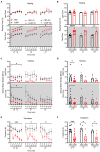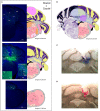CGRP Administration Into the Cerebellum Evokes Light Aversion, Tactile Hypersensitivity, and Nociceptive Squint in Mice
- PMID: 35547239
- PMCID: PMC9082264
- DOI: 10.3389/fpain.2022.861598
CGRP Administration Into the Cerebellum Evokes Light Aversion, Tactile Hypersensitivity, and Nociceptive Squint in Mice
Abstract
The neuropeptide calcitonin gene-related peptide (CGRP) is a major player in migraine pathophysiology. Previous preclinical studies demonstrated that intracerebroventricular administration of CGRP caused migraine-like behaviors in mice, but the sites of action in the brain remain unidentified. The cerebellum has the most CGRP binding sites in the central nervous system and is increasingly recognized as both a sensory and motor integration center. The objective of this study was to test whether the cerebellum, particularly the medial cerebellar nuclei (MN), might be a site of CGRP action. In this study, CGRP was directly injected into the right MN of C57BL/6J mice via a cannula. A battery of tests was done to assess preclinical behaviors that are surrogates of migraine-like symptoms. CGRP caused light aversion measured as decreased time in the light zone even with dim light. The mice also spent more time resting in the dark zone, but not the light, along with decreased rearing and transitions between zones. These behaviors were similar for both sexes. Moreover, significant responses to CGRP were seen in the open field assay, von Frey test, and automated squint assay, indicating anxiety, tactile hypersensitivity, and spontaneous pain, respectively. Interestingly, CGRP injection caused significant anxiety and spontaneous pain responses only in female mice, and a more robust tactile hypersensitivity in female mice. No detectable effect of CGRP on gait was observed in either sex. These results suggest that CGRP injection in the MN causes light aversion accompanied by increased anxiety, tactile hypersensitivity, and spontaneous pain. A caveat is that we cannot exclude contributions from other cerebellar regions in addition to the MN due to diffusion of the injected peptide. These results reveal the cerebellum as a new site of CGRP actions that may contribute to migraine-like hypersensitivity.
Keywords: CGRP; anxiety; cerebellum; light aversion; migraine; pain.
Copyright © 2022 Wang, Duong, Rea, Waite, Huebner, Flinn, Russo and Sowers.
Conflict of interest statement
AR is a consultant for Lundbeck, Amgen, Novartis, Eli Lilly, AbbVie, and Schedule 1 Therapeutics. The remaining authors declare that the research was conducted in the absence of any commercial or financial relationships that could be construed as a potential conflict of interest.
Figures







Similar articles
-
Stimulation of CGRP-expressing neurons in the medial cerebellar nucleus induces light and touch sensitivity in mice.Neurobiol Pain. 2022 Jun 23;12:100098. doi: 10.1016/j.ynpai.2022.100098. eCollection 2022 Aug-Dec. Neurobiol Pain. 2022. PMID: 35782531 Free PMC article.
-
Induction of Migraine-Like Photophobic Behavior in Mice by Both Peripheral and Central CGRP Mechanisms.J Neurosci. 2017 Jan 4;37(1):204-216. doi: 10.1523/JNEUROSCI.2967-16.2016. J Neurosci. 2017. PMID: 28053042 Free PMC article.
-
Stimulation of Posterior Thalamic Nuclei Induces Photophobic Behavior in Mice.Headache. 2020 Oct;60(9):1961-1981. doi: 10.1111/head.13917. Epub 2020 Aug 4. Headache. 2020. PMID: 32750230 Free PMC article.
-
CGRP and migraine: could PACAP play a role too?Neuropeptides. 2013 Dec;47(6):451-61. doi: 10.1016/j.npep.2013.10.010. Epub 2013 Oct 23. Neuropeptides. 2013. PMID: 24210136 Free PMC article. Review.
-
Involvement of the cerebellum in migraine.Front Syst Neurosci. 2022 Oct 13;16:984406. doi: 10.3389/fnsys.2022.984406. eCollection 2022. Front Syst Neurosci. 2022. PMID: 36313527 Free PMC article. Review.
Cited by
-
Stimulation of CGRP-expressing neurons in the medial cerebellar nucleus induces light and touch sensitivity in mice.Neurobiol Pain. 2022 Jun 23;12:100098. doi: 10.1016/j.ynpai.2022.100098. eCollection 2022 Aug-Dec. Neurobiol Pain. 2022. PMID: 35782531 Free PMC article.
-
Combined effects of cannabidiol and Δ9-tetrahydrocannabinol alleviate migraine-like symptoms in mice.Cephalalgia. 2025 Feb;45(2):3331024251314487. doi: 10.1177/03331024251314487. Cephalalgia. 2025. PMID: 39988876 Free PMC article.
-
Shared and independent roles of CGRP and PACAP in migraine pathophysiology.J Headache Pain. 2023 Apr 3;24(1):34. doi: 10.1186/s10194-023-01569-2. J Headache Pain. 2023. PMID: 37009867 Free PMC article. Review.
-
Sex differences in the effects of calcitonin gene-related peptide signaling on migraine-like behavior in animal models: a narrative review.Front Neurol. 2025 Jul 10;16:1603758. doi: 10.3389/fneur.2025.1603758. eCollection 2025. Front Neurol. 2025. PMID: 40708951 Free PMC article. Review.
-
A Vestibular Challenge Combined with Calcitonin Gene-Related Peptide (CGRP) Promotes Anxiety-Like Behaviors.eNeuro. 2024 Jul 26;11(7):ENEURO.0270-23.2024. doi: 10.1523/ENEURO.0270-23.2024. Print 2024 Jul. eNeuro. 2024. PMID: 38997144 Free PMC article.
References
-
- Disease GBD, Injury I, Prevalence C. Global, regional, and national incidence, prevalence, and years lived with disability for 354 diseases and injuries for 195 countries and territories, 1990-2017: a systematic analysis for the Global Burden of Disease Study 2017. Lancet. (2018) 392:1789–858. 10.1016/S0140-6736(18)32279-7 - DOI - PMC - PubMed
Grants and funding
LinkOut - more resources
Full Text Sources
Research Materials

